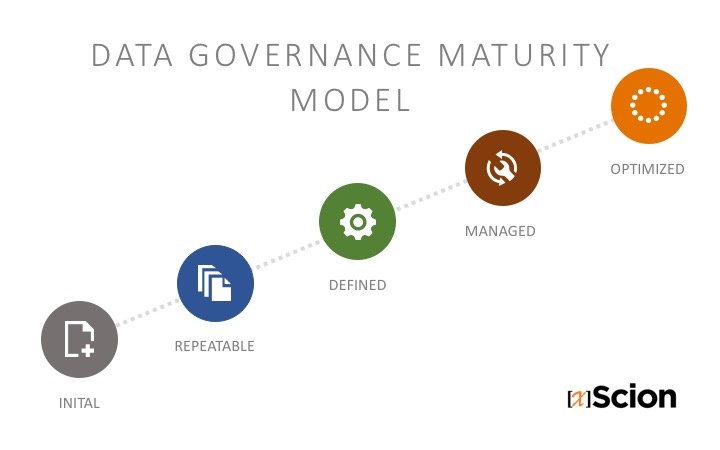Over the last couple of years, I’ve helped many organizations of different sizes and various industries that were struggling with Data Governance. Every organization recognized the importance of governing their data assets, and all were governing their data, at some level. Why was their Data Governance not working? It needed to mature.
These conversations prompted me to think about how to best help companies measure how “mature” their Data Governance capabilities are. As with any operational function, Data Governance can be described in 5 maturity levels. As organizations mature through each level, their ability to manage data becomes more automated and consistent, thus reducing regulatory and compliance risk.

Data Governance Maturity Levels:
Level 1: Initial
- Data Quality is determined by the skill level of IT Staff
- Processes are undocumented, ad hoc and chaotic
- No Single Source of Truth, multiple copies and formats of the same data
Level 2: Repeatable
- Data Governance tools might exist but not implemented to maximize business value
- No distinction between logical and physical data
- Business meaning of data is not consistently documented or understood
- Governance principles might be implemented “locally” by not consistently at the Enterprise level
Level 3: Defined
- Data Governance Program implemented at the enterprise level so that business meaning of data is understood
- Data quality standards are consistently enforced and tested
- Current state processes are documented, reviewed and improved as needed
- Data Governance tools are used to record and maintain documentation, automate management and proactively monitor & tune governance capabilities
Level 4: Managed
- Current state processes are managed and improved through the use of metrics and analytics
- Metadata is cataloged for all corporate data structures, reducing duplication
- Data Governance team can provide details of where data exists and all business definitions
- Production data is regularly audited to ensure quality
- Data Governance tools are used to establish and manage enterprise data repositories
Level 5: Optimized
- Continuous, incremental of governance processes by applying advanced technology solutions
- Continuous improvement of data quality and automated monitoring of data access
- Data Governance team approves any and all changes to PROD data and documents them in an enterprise metadata repository
How Mature is Your Data Governance?
As you assess where your Data Governance capabilities fall on this scale, ask yourself these questions:
- Do we have a person or group of people who are dedicated to understanding and communicating to the entire organization, all types of risks associated with our data?
- Do we have a person or group of people who document rules for managing our data in a way that we can demonstrate compliance during an audit?
- Have we developed and communicated clear policies related to data security? Do we feel confident about our ability to manage and protect confidential data from unauthorized access?
- Do we have defined Metadata Management policies that identify what data we have, where it resides, how it’s defined and used. Is this information available 24/7 to anyone who requests it?
- Do we have an established formal approach for managing Data Quality which includes: recording of issues, proactive ways to identify and address issues, using logs to track and prioritize issue resolution?
- Do we have an Enterprise Data Warehouse which provides easy access to authorized users, supports data integration and Business Intelligence/Reporting?
- Have we assigned people and implemented technologies to manage and share our master and reference data?
- Have we established a Data Governance Council consisting of business, IT and executive stakeholders, who are given specific responsibilities for governing our data?




